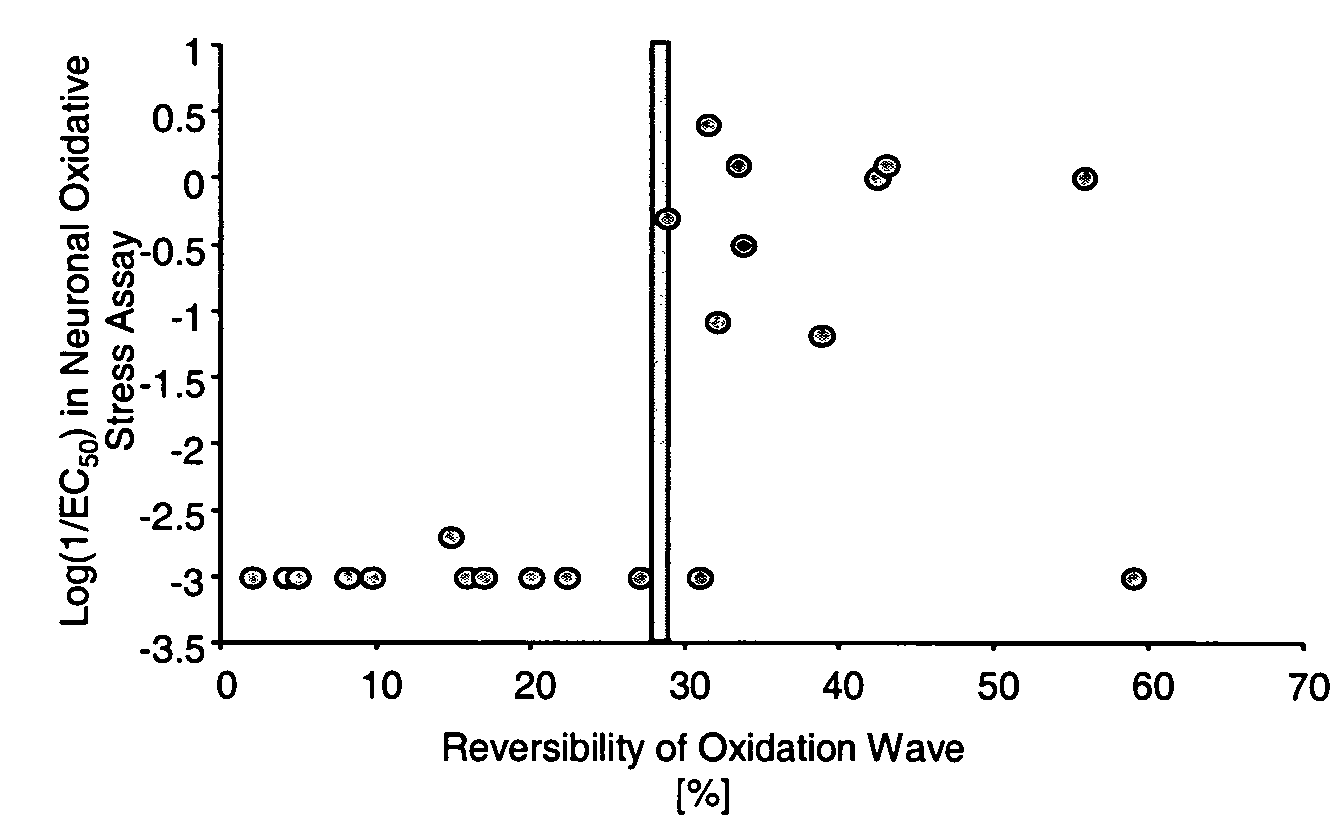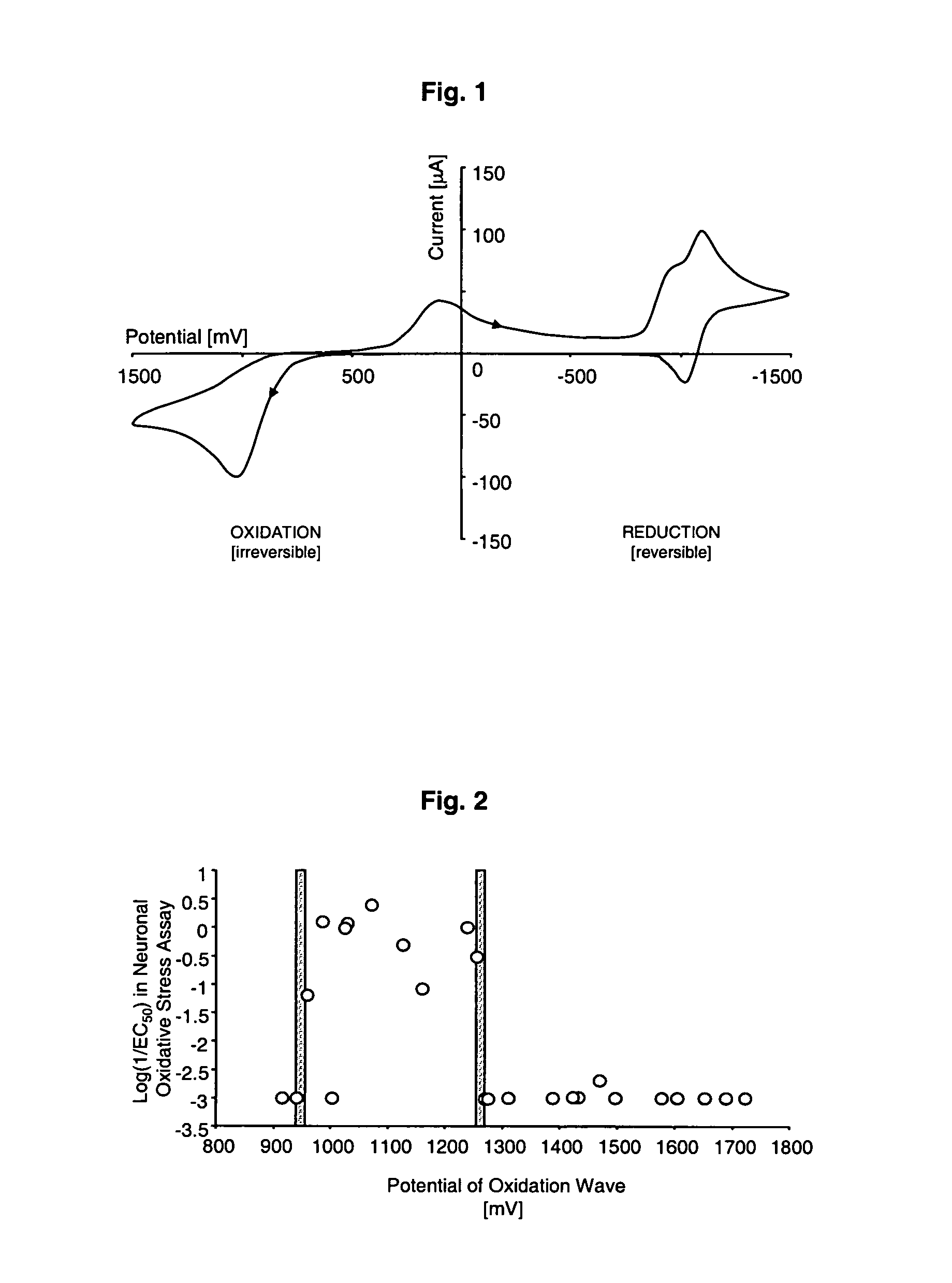Identifying therapeutic compounds based on their physical-chemical properties
- Summary
- Abstract
- Description
- Claims
- Application Information
AI Technical Summary
Benefits of technology
Problems solved by technology
Method used
Image
Examples
example 1
Cyclic Voltammetry Measurement
[0166]The cyclic voltammetry measurement was conducted in a three-electrode system comprising a microelectrode made from platinum (a disk of 1.6 mm2 area), a counter electrode made from a coiled platinum wire and a silver / silver chloride reference electrode, on a voltammetric analyzer Epsilon with a C-3 cell, all from Bioanalytical Systems (West Lafayette, Ind.).
a. Preparation of the Solution
[0167]A solution of tetrabutyl ammonium perchlorate (TBAP) (500 mM final concentration) in N,N-dimethyl formamide (DMF) (5 mL) was prepared in a graduated flask. The compound was added to reach a concentration of 10 mM. The solution was stirred and sonicated if necessary to make sure that the compound was fully dissolved.
b. Preparation of the Electrodes
[0168]The reference electrode was kept in a 3 M solution of NaCl in distilled water. The reference electrode was rinsed with water, then methanol, and dried by air blow. The reference electrode was gently shaken, if n...
example 2
Square Wave Voltammetry Measurement
[0181]The square wave voltammetry measurement was conducted in a three-electrode system comprising a microelectrode made from platinum (a disk of 1.6 mm2 area), a counter electrode made from coiled platinum wire and a silver / silver chloride reference electrode, on a voltammetric analyzer CV-50W with a C-3 cell, all from Bioanalytical Systems (West Lafayette, Ind.).
Procedure
a. Prepare the Solution
[0182]A solution of tetrabutyl ammonium perchlorate (TBAP) (500 mM final concentration) in N,N-dimethyl formamide (DMF) (5 mL) is prepared in a graduated flask. The compound is added to reach an arbitrary concentration, 10 mM is desired but less is acceptable. This method is especially useful for low concentration analytes, those molecules that are difficult to dissolve in DMF or available only in small quantities. The solution is stirred and sonicated if necessary to make sure that the compound is dissolved to the best of its ability.
b. Prepare the Electro...
example 3
Determination of Activity Utilizing the Cell Elam Assay
[0190]Endothelial-Leukocyte Adhesion Molecule (ELAM), also known as E-selectin, is expressed on the surface of endothelial cells. In this assay, lipopolysaccharide (LPS) and IL-1β were used to stimulate the expression of ELAM; test agents were tested for their abilities to reduce this expression, in accordance with studies showing that reduction of leukocyte adhesion to endothelial cell surface was associated with decreased cellular damage (e.g., Takada, M. et al., Transplantation 64: 1520-25, 1997; Steinberg, J. B. et al., J. Heart Lung Trans. 13:306-313, 1994).
[0191]Endothelial cells may be selected from any of a number of sources and cultured according to methods known in the art; including, for example, coronary artery endothelial cells, human brain microvascular endothelial cells (HBMEC; Hess, D. C. et al., Neurosci. Lett. 213(1): 37-40, 1996), or lung endothelial cells. Cells were conveniently cultured in 96-well plates. C...
PUM
 Login to View More
Login to View More Abstract
Description
Claims
Application Information
 Login to View More
Login to View More - R&D
- Intellectual Property
- Life Sciences
- Materials
- Tech Scout
- Unparalleled Data Quality
- Higher Quality Content
- 60% Fewer Hallucinations
Browse by: Latest US Patents, China's latest patents, Technical Efficacy Thesaurus, Application Domain, Technology Topic, Popular Technical Reports.
© 2025 PatSnap. All rights reserved.Legal|Privacy policy|Modern Slavery Act Transparency Statement|Sitemap|About US| Contact US: help@patsnap.com



